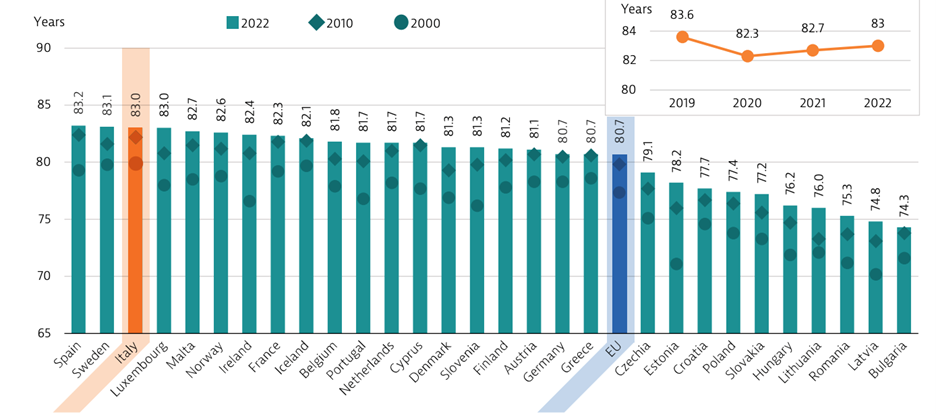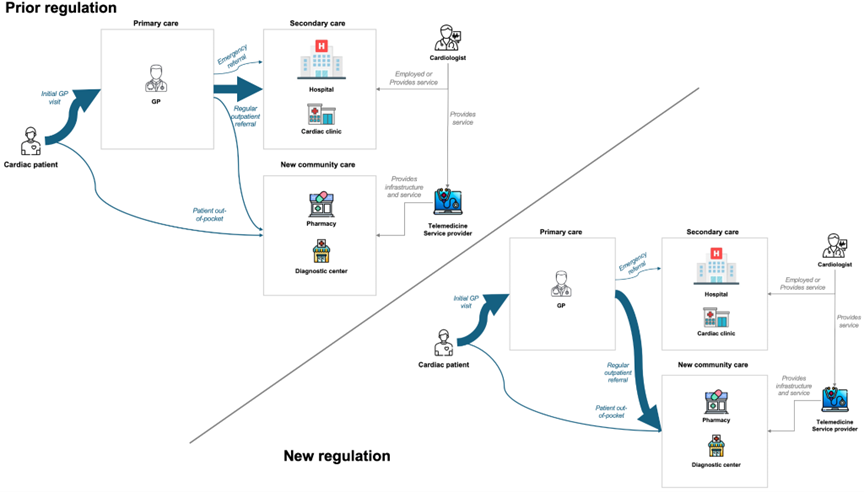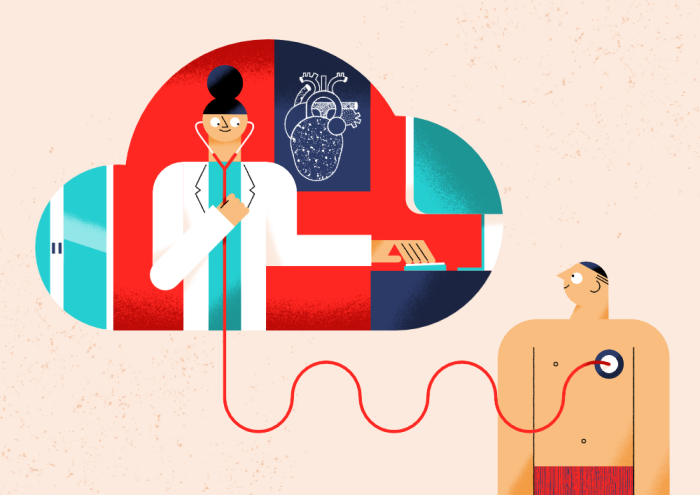Italy is pioneering a push for telemedicine and home care in cardiology with the application of groundbreaking new regulation that took effect in January 2024. This is radically simplifying the patient pathway for Electrocardiogram (ECG) tests. As a result, innovative service providers are growing rapidly by leveraging integrated remote monitoring solutions to provide ECGs via extensive pharmacy networks. AI-based ECG analysis solutions such as Cardiomatics play a critical role to help service providers guarantee high diagnostic accuracy with fast turnaround times.
Italy’s Decentralized Healthcare System Shows Strong Overall Performance but Faces Challenges
Italy’s healthcare system, known as the Servizio Sanitario Nazionale (SSN), provides universal coverage and is largely free at the point of delivery. The system is decentralized with 19 regions and two autonomous provinces responsible for the delivery of health services through Local Health Units (ASLs).
In terms of healthcare spending, Italy allocates about 9.4% of its GDP to healthcare, below the OECD average of 11%. Despite this, Italy boasts one of the highest life expectancies in the EU at 83.0 years, which has recovered well following a large decline due to COVID in 2020. This reflects the overall effectiveness of Italy’s health system.

However, important challenges remain. While the decentralized HC system structure allows for significant regional autonomy, it also leads to large variations in healthcare quality across the country, for example in the availability of healthcare professionals.

Italy’s Traditional ECG Care Pathway Was Fraught with Challenges
Diagnostic Cardiology epitomizes these broader challenges. Prior to the new regulation, getting a consultation with a cardiologist or getting a needed diagnostic cardiology test often involved long waiting times. For instance, the average waiting time for an echocardiogram at Turin’s Molinette Hospital was 31 days in 2016 and an even longer 53 days for a Holter ECG.
These delays often led patients to seek faster albeit more expensive services in the private sector. As a response, a number of private service providers started offering innovative remote diagnostic testing services that patients could access directly through their local pharmacies. This was enabled by the advent of connected and easy-to-use ECG devices integrated with telemedicine solutions that allowed the service providers’ cardiologists to assess the recordings remotely.
Whilst providing an effective way for patients to get access to much needed diagnostic cardiology tests, the rise in out-of-pocket ECG testing in pharmacies created an unequal system where affordability dictated access to timely care.
Telemedicine as the New Standard to Drive Patient Access and Speed of ECG Diagnostics
Italy has been on a journey towards broader use of telemedicine for the last decade, starting with its first national guidelines for the development of telemedicine services in 2014. The Covid-19 emergency in 2021 accelerated the regulatory shift by highlighting the need not to overload hospital structures as well as the opportunities offered by digital healthcare.
Following the covid crisis, breakthrough regulation mandating and supporting the regions to shift certain outpatient care towards telemedicine services was adopted in 2022, including a focus on cardiology. This regulation simplifies the patient pathway for ECG tests with the aim to make these services more accessible.
Under the new system, most patients will now receive ECG tests at local pharmacies or diagnostic centers rather than having to visit hospitals or specialist clinics.
- Prescriptions for ECGs can be obtained from general practitioners (GPs).
- Patients visit pharmacies or other diagnostic centers to receive and wear the ECG device (e.g. Holter monitor).
- Telemedicine service providers analyze the ECG data remotely, including a remote assessment by a cardiologist.
- Patients only need to see a cardiologist if further evaluation is required.
This new system is expected to result in a massive shift of ECG test volume from secondary care to community care settings such as pharmacies and diagnostic centers. Italy already boasts a tight-knit network of 18,000 pharmacies, so those are expected to pick up the lion’s share of the ECG test volume supported by service providers.
The shift will happen over the next 3 years while the regions implement the new systems as mandated by the regulation. Some regions in northern Italy, such as Lombardia, have already implemented the new approach, triggering a fast scale-up of diagnostic cardiology services in pharmacies.
Marco Mazzanti, Scientific Director of International Research Frameworks on Artificial Intelligence in Cardiology, notes, “Pharmacies often serve as accessible points of care for many patients. Integrating AI-powered ECG analysis into these networks can enhance patient care. Point-of-Care Testing (POCT) is very important in this sense: Pharmacies equipped with AI-enabled ECG devices can perform quick tests and provide immediate analysis, reducing the need for specialist referrals. AI can also facilitate remote monitoring of patients with cardiac conditions, allowing pharmacies to track patient data and alert them to any significant changes. No less important, AI can support pharmacists in making informed clinical decisions about risk stratification where AI algorithms can assess the risk levels of patients based on their ECG data and other health metrics, enabling targeted interventions. Decision Trees and Predictive Analytics tools can assist pharmacists in determining the best course of action for patients based on their ECG results and medical history. Finally AI tools can empower patients by providing them with insights into their cardiac health. In particular some of the mobile applications by AI-powered apps can allow patients to perform ECG tests at home using portable devices, with results analyzed and reported instantly providing patients with personalized information and recommendations based on their ECG results, so helping them understand their condition and take proactive measures.”

Leading Service Providers are Scaling Rapidly with Remote Monitoring and AI Solutions
The introduction of this regulation has catalyzed rapid growth in the ECG analysis service industry. Numerous new entrants, including ECG hardware manufacturers integrating vertically, clinics, and existing service providers, are expected to enter this expanding market. To be able to provide ECGs for patients under the public reimbursement scheme and not only the private market, the providers need to be accredited by the region. This requires obtaining local certification for the telemedicine system used, which must share data with public electronic health records that are being set-up for each region. The exact rules and systems for this vary per region.
Gian-Luca Ziliani, an industry expert, notes, “We are witnessing a significant influx of new service providers, which I expect will consolidate over the next 3-5 years. The key players will be those who can offer scalable solutions across multiple regions, access and drive up to date technologies – both hw and sw – and have distribution to the local pharmacies or diagnostic centers.”
A borader trend across Europe
Across Europe, many healthcare systems are facing similar challenges. On the one hand, the demand for diagnostic cardiology continues to grow rapidly, driven by long-term demographic trends as well as the increased availability of compact or wearable diagnostic devices such as patch ECG devices and smartwatches. On the other hand, the imperative to constrain costs and widespread lack of staff have been accelerated since the covid crisis. We see this tension already bringing parts of the healthcare system to a breaking point, as evidenced by backlogs at providers and months-long waiting lists for patients.
Italy was able to take the learnings from an acute covid crisis to accelerate its journey towards widespread use of telemedicine in diagnostic cardiology and other specialties. It is paving the way with the new regulation that came into effect since January 2024 and shifts the regular outpatient referral for ECGs and other tests to be done at pharmacies or diagnostic centers rather than in hospitals or cardiac clinics.
We see other European healthcare systems progressing in the same direction, although not with the same speed. Both Germany and Poland now allow general practitioners to perform ECG tests themselves, for example, reducing the need for long and expensive secondary care referrals.
AI-powered solutions such as Cardiomatics are essential to realize this shift by supporting practitioners across care settings to provide high-quality ECG-based diagnosis and monitoring much faster, more personalized, and to many more patients.
Sources
- OECD/European Observatory on Health Systems and Policies (2023), Italy: Country Health Profile 2023, State of Health in the EU, OECD Publishing, Paris, https://doi.org/10.1787/633496ec-en.
- E Olivero, F Bert, C Corezzi, P Rossello, P Alaria, R Siliquini, A Scarmozzino, Waiting times in cardiology and quality of care: analysis of performances in an Italian hospital, European Journal of Public Health, Volume 29, Issue Supplement_4, 2019, ckz186.369, https://doi.org/10.1093/eurpub/ckz186.369
- M Betti, CS De Tommaso, F Maino, Health Inequalities in Italy: Comparing Prevention, Community Health Services, and Hospital Assistance in Different Regions, Social Development Issues – Alternative Approaches to Global Human Needs, Volume 45, Issue 1, 2023 https://journals.publishing.umich.edu/sdi/article/id/3906/
- Italian Ministry of Health, https://www.salute.gov.it/portale/ehealth/dettaglioContenutiEHealth.jsp?lingua=italiano&id=5525&area=eHealth&menu=telemedicina

